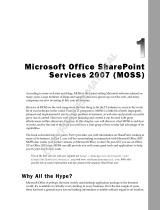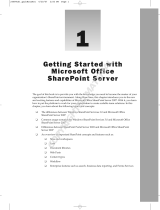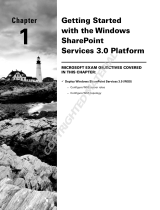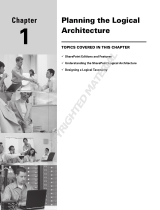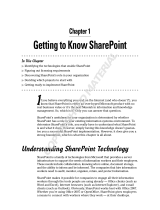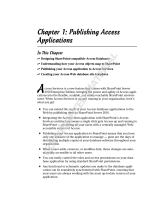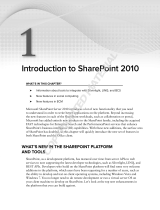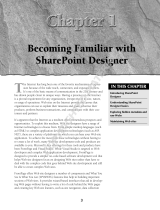Page is loading ...

February 2006
Microsoft Office SharePoint Server 2007
Evaluation Guide

www.microsoft.com/office/preview/servers/sharepointserver
i
Abstract
This evaluation guide is designed to give you a solid understanding of the design goals
and feature set for Microsoft® Office SharePoint® Server 2007 and a familiarity with the
product implementation. It provides an overview of the solutions and benefits provided
by Office SharePoint Server 2007 as well as descriptions of new and improved features in
the areas of portal, search, content management, business processes, and business
intelligence. It also provides a hands-on tour of the product’s main feature areas and
concludes with useful information for administrators and developers.
The ultimate goal of this guide is to aid the reader in performing a thorough and effective
evaluation of Office SharePoint Server 2007. This guide is intended for anyone who is
interested in learning more about Office SharePoint Server 2007 and wants hands-on
experience.
For the latest information about Office SharePoint Server 2007, go to
http://www.microsoft.com/office/preview. For other product information resources, refer
to the “For More Information” section at the end of this guide.

www.microsoft.com/office/preview/servers/sharepointserver
ii
Table of Contents
Introduction .................................................................................................. 1
Resources Available for Evaluating Office SharePoint Server 2007 ....................... 2
How to Use This Guide .................................................................................. 2
Overview of This Guide .................................................................................. 2
Product Overview .......................................................................................... 4
Effectively Manage and Repurpose Your Information Assets ............................... 4
Accelerate Internal and External Shared Business Processes .............................. 5
Make Better-Informed Decisions through Centralized Access to Information ......... 5
Share Business Information Within and Outside Your Organization ...................... 6
Use a Single, Integrated Platform to Manage Intranet, Extranet, and Internet
Applications ................................................................................................. 7
Top 10 Benefits ............................................................................................. 8
Features at a Glance .................................................................................... 10
Portal ........................................................................................................ 10
Content Management .................................................................................. 13
Document Management ............................................................................ 14
Records Management ............................................................................... 15
Web Content Management ........................................................................ 18
Search ....................................................................................................... 21
Business Processes ..................................................................................... 25
Business Intelligence ................................................................................... 27
Architectural Overview ................................................................................ 30
Operating System and Database Services ...................................................... 31
Windows SharePoint Services ....................................................................... 31
Office SharePoint Server 2007: Applications and Services ................................ 32
Server Applications .................................................................................. 32
Shared Services ...................................................................................... 33
Installing Your Evaluation Server ................................................................ 34
Product Tour ............................................................................................... 35
An Administrator’s Perspective ................................................................... 36
A Developer’s Perspective ........................................................................... 37
For More Information .................................................................................. 38
Hardware and Software Requirements ........................................................ 38

www.microsoft.com/office/preview/servers/sharepointserver
1
Introduction
Welcome to the evaluation guide for Microsoft Office SharePoint Server 2007. The goal of this
guide is to help you gain sufficient knowledge and understanding of Office SharePoint Server
2007 to evaluate this product from Microsoft.
Office SharePoint Server 2007 helps organizations gain better control and insight over their
content, streamline their business processes, and access and share information. In addition,
Office SharePoint Server 2007 gives IT professionals the tools they need for server
administration and application extensibility and interoperability. Office SharePoint Server
2007 helps you to:
• Get more out of your information.
• Streamline your business processes.
• Simplify the way people work together.
• Ease server administration, extensibility, and interoperability.
These benefits are further described in the Product Overview section of this guide. The Top
10 Benefits section highlights the most important ways Office SharePoint Server 2007 can
help your organization make better use of its business information and processes.
Features at a Glance details the new and enhanced features for this release of Office
SharePoint Server including:
• Portal
• Search
• Content Management, including Document, Records, and Web Content
• Business Processes
• Business Intelligence
With this knowledge, you will be able to properly evaluate these new features and readily
describe their capabilities to your colleagues, clients, and business partners.
An evaluation guide is also available for Microsoft Windows® SharePoint Services (version 3).
However, solution developers, IT professionals, technical business decision makers,
journalists, and analysts can read the Office SharePoint Server 2007 Evaluation Guide without
referring to the Windows SharePoint Services Evaluation Guide.

www.microsoft.com/office/preview/servers/sharepointserver
2
Resources Available for Evaluating Office SharePoint Server
2007
Many resources are available to help you evaluate Office SharePoint Server 2007, including
the following:
• Documentation will help you install Office SharePoint Server 2007.
• The SharePoint Products and Technologies Web site at
http://www.microsoft.com/sharepoint offers a variety of white papers and other
resources.
• The Microsoft MSDN® Web site at http://msdn.microsoft.com/sharepoint/ offers numerous
technical resources from a developer’s perspective about SharePoint Products and
Technologies.
• The Microsoft TechNet Web site at http://www.microsoft.com/technet/ provides a
clearinghouse of resources to help you deploy, maintain, and support Office SharePoint
Server 2007.
Microsoft encourages you to use these resources as aids in installing and evaluating Office
SharePoint Server 2007.
How to Use This Guide
Overview of This Guide
This guide has the following sections. For best results, review them in order, as each section
builds on concepts presented in preceding sections.
Product Overview
Highlights key features of Office SharePoint Server 2007 and describes how these features
can benefit organizations that build and manage content-rich Web sites.
Top 10 Benefits
Identifies the top 10 business and technical benefits that Microsoft customers can realize
through their deployment and use of Office SharePoint Server 2007.
Features at a Glance
Provides information to help you understand, describe, and evaluate the new and enhanced
features of Office SharePoint Server 2007. This section will be of interest to anyone who
plans, builds, deploys, or manages business solutions using Office SharePoint Server 2007.
Architectural Overview
Describes the logical architecture of Office SharePoint Server 2007.

www.microsoft.com/office/preview/servers/sharepointserver
3
Installing Your Evaluation Server
Provides step–by-step instructions for installing Office SharePoint Server 2007 in a single-
server environment so that you can evaluate product features. More information will be
available in a future release of this document.
Product Tour
Provides step-by-step instructions for configuring and demonstrating each new feature of
Office SharePoint Server 2007. More information will be available in a future release of this
document.
An Administrator’s Perspective
Provides information needed to plan, build, deploy, and manage an Office SharePoint Server
2007 solution. More information will be available in a future release of this document.
A Developer's Perspective
Introduces the tools that developers use to design and develop custom solutions using Office
SharePoint Server 2007. More information will be available in a future release of this
document.
For More Information
Provides links to sources of further information about Office SharePoint Server 2007, such as
white papers, community sites, and the Windows SharePoint Services Support Web site.

www.microsoft.com/office/preview/servers/sharepointserver
4
Product Overview
Office SharePoint Server 2007 is an integrated suite of server applications that improves
organizational effectiveness by providing comprehensive control over electronic content;
accelerating shared business processes; and facilitating better-informed decisions and
information-sharing across boundaries.
Effectively Manage and Repurpose Your Information Assets
Get more value from your content by providing comprehensive control over the storage,
security, distribution, reuse, and management of documents and other electronic content
such as Web pages, PDF files, and e-mail messages.
Control documents through detailed, extensible policy management
Define customized document management policies to control item-level access rights,
retention period, expiration actions, and document-auditing settings. Policy integration with
familiar client applications makes compliance transparent and easy for employees. Extensible
design helps organizations to modify product behavior to suit their unique business needs.
Centrally store, manage, and access documents across the enterprise
Organizations can store and organize all business documents and content in one central
location, and users have a consistent mechanism to navigate and find relevant information.
Default repository settings can be modified to add workflow, define retention policies, and
add new templates and content types.
Simplify content reuse and information repurposing
Submit work from collaborative sites to portals using tools that simplify content reuse and
publishing. Simplify management of multilingual content through document library templates
designed to maintain a relationship between original and translated versions of documents.
Use slide libraries as an easy way to share and reuse Microsoft Office PowerPoint® 2007
slides.

www.microsoft.com/office/preview/servers/sharepointserver
5
Accelerate Internal and External Shared Business Processes
Make business process initiation, participation, tracking, and reporting easy and flexible by
providing a simple, consistent user experience through familiar client applications. Optimize
the way people, content, and processes interact within and across organizations.
Boost employee productivity by simplifying everyday business activities
Take advantage of workflows to automate and gain more visibility into common business
activities like document review and approval, issue tracking, and signature collection.
Integration with familiar client applications, e-mail, and Web browsers simplifies the user
experience. End users can easily define and model their own processes using familiar
Microsoft tools.
Extend business processes across the organization
Enhance your relationships with customers, partners, and suppliers by making forms-based
business processes easily accessible to them, even if they haven’t installed client software.
Built-in validation rules and integration with Microsoft information rights management (IRM)
help to ensure that critical business information can be collected with enhanced security and
accuracy.
Focus on strategic, value-added tasks instead of redundant activities
Information gathered using electronic forms can be integrated easily into line-of-business
(LOB) systems, stored in document libraries, used to start workflow processes, or submitted
to Web services. This helps users avoid duplicate efforts and costly errors from manual data
entry, and it helps ensure they have access to accurate, real-time data.
Make Better-Informed Decisions through Centralized Access
to Information
Provide a single, integrated location where employees can efficiently find organizational
resources, access corporate knowledge, and leverage business insight in order to make
better-informed decisions.
Present business-critical information in one central location
Create live, interactive business intelligence (BI) portals that assemble and display business
information from disparate sources, using integrated BI capabilities such as dashboards, Web
Parts, key performance indicators (KPIs), and business data connectivity technologies.
Centralized Report Center sites give users a single place to find the latest reports,
spreadsheets, or KPIs.

www.microsoft.com/office/preview/servers/sharepointserver
6
Quickly connect people and information
SharePoint Enterprise Search incorporates business data and information about people with
documents and Web pages to provide more comprehensive results. Tools for query hit
highlighting, duplicate collapsing, “did you mean” spelling correction, and alerts help users
locate what they want within search results.
Unlock business data
Out-of-the-box (OOB) connectors provide accessibility to data in SAP and Siebel systems.
With the Business Data Catalog, IT can create a pool of connections to business systems,
which can be reused easily by business users to create personalized, interactive views into
back-end data from browsers—all without writing any code.
Leverage your unstructured business networks to drive better decisions
Employees can use new knowledge management tools to get the most from their powerful
unstructured business networks, both inside and outside their organizations, by connecting
with people more quickly and efficiently. By exploring these undocumented business
relationships and finding subject matter experts, individuals can make better decisions more
quickly.
Work when and where you want
With offline access to SharePoint lists and document libraries, you can free yourself from the
limitations of corporate network connectivity.
Share Business Information Within and Outside Your
Organization
Simplify and help boost the security and efficiency of collaboration and knowledge sharing
within and across organizational boundaries.
Broadly share business data while helping to protect sensitive information
Excel Services running on Office SharePoint Server 2007 provides access to real-time,
interactive Microsoft Office Excel® 2007 spreadsheets from a Web browser. Use these
spreadsheets to maintain and efficiently share one central, up-to-date version, while helping
to protect any proprietary information, such as financial models, embedded in documents.

www.microsoft.com/office/preview/servers/sharepointserver
7
Enhance customer and partner relationships
With smart, standards-based, electronic forms–driven solutions, you can collect business
information from customers, partners, and suppliers through a Web browser. Lightweight
Directory Access Protocol (LDAP) integration and support for other pluggable authentication
providers makes it easier to implement extranet SharePoint environments, improving
connectivity outside your organization.
Effectively manage and share business insight
Report Center provides a centralized location to access business-critical information. It
simplifies control and sharing of reports, Office Excel spreadsheets, KPIs, and dashboards
within organizations and teams. Users can define personalized reports and dashboards,
browse reports by category, or view a calendar of upcoming reports and subscribe to ones
that are relevant.
Use a Single, Integrated Platform to Manage Intranet,
Extranet, and Internet Applications
Office SharePoint Server 2007 provides a scalable enterprise platform that can grow with
your business without the need for costly add-ons. IT staff can spend more time on the
strategic tasks only they can perform and help drive enhanced business value and positive
change throughout your organization.
Boost employee productivity through innovative, enterprise-wide solutions
Make use of powerful development tools and an open, scalable architecture with support for
Web services and interoperability standards, including XML and Simple Object Access Protocol
(SOAP), to build and extend applications that incorporate business system information and
integrated workflow.
Simplify site staging and content deployment
Use OOB site-starter templates for common Web sites, with Area and Page Layout templates
and preconfigured navigation. Configure content deployment paths between different
computers or the same computer. Schedule processes that define the scope of content and
the frequency of recurring deployments.
Get the tools you need to ease deployment, management, and system
administration
Robust system-monitoring and usage-tracking tools help to isolate and solve problems faster,
and improve the operational efficiency of the system infrastructure.

www.microsoft.com/office/preview/servers/sharepointserver
8
Top 10 Benefits
Office SharePoint Server 2007 provides an integrated suite of easy-to-use server applications
that boost organizational effectiveness and optimize the way that people, content, processes,
and business applications interact. Here are the top 10 ways Office SharePoint Server 2007
can help your organization:
1. Provide a simple, familiar, and consistent user experience.
Office SharePoint Server 2007 is tightly integrated with familiar client applications, e-mail,
and Web browsers to provide a consistent user experience that simplifies how people interact
with content, processes, and business data. Employees can easily use services to accomplish
business activities without having to depend on IT staff.
2. Boost employee productivity by simplifying everyday business activities.
Take advantage of OOB workflows for initiating, tracking, and reporting common business
processes such as document review and approval, issue tracking, and signature collection—
without any coding. Modifying and extending these OOB processes is made easy through
tools like Microsoft Visual Studio® and Microsoft Office SharePoint Designer 2007 (the next
release of Microsoft Office FrontPage® 2003).
3. Help meet regulatory requirements through comprehensive control over content.
Help ensure your sensitive business information can be controlled and managed effectively—
and reduce litigation risk for your organization—by specifying retention and auditing policies
for business records in accordance with compliance regulations. IRM and the content control
mechanisms help protect proprietary and confidential information, even when users aren’t
connected to a server.
4. Effectively manage and repurpose content to gain increased business value.
Business users can easily author content for Web sites and submit it for approval and
scheduled deployment to the Internet. Managing multilingual content is simplified in Office
SharePoint Server 2007 through new document library templates specifically designed to
maintain a relationship between the original and translated versions of a document.
5. Simplify organization-wide access to structured and unstructured information
across disparate systems.
Give users access to business data in common LOB systems like SAP and Siebel through OOB
connectors in Office SharePoint Server 2007. Users can also create personalized interactions
with business systems by dragging predefined, configurable back-end connections. Managed

www.microsoft.com/office/preview/servers/sharepointserver
9
document repositories help organizations store and organize business documents in one
central location.
6. Connect people with information and expertise.
SharePoint Enterprise Search incorporates business data with information about people,
documents, and Web pages to produce comprehensive, relevant results. Rich search
functionality like duplicate collapsing, spelling correction, and alerts improves the relevance
of the results and helps users easily find what they need within the search results.
7. Accelerate business processes and maintain control of your electronic forms
environment.
Use smart, electronic forms-driven solutions to collect critical business information from
customers, partners, and suppliers through a Web browser without coding any custom
applications. Built-in data validation rules help you accurately and consistently gather data
that can be directly integrated into back-end systems, avoiding redundancy and errors
resulting from manual data re-entry.
8. Share business data while preserving its consistency and helping to protect
sensitive information.
Give employees access to real-time, interactive Office Excel spreadsheets from a Web
browser through Excel Services running on Office SharePoint Server 2007. Use these
spreadsheets to maintain and efficiently share one central, up-to-date version while helping
to protect any proprietary information embedded in the documents.
9. Facilitate better-informed decisions by presenting business-critical information in
one central location.
Make it easy to create live, interactive BI portals that assemble and display business-critical
information from disparate sources, using integrated BI capabilities such as dashboards, Web
Parts, scorecards, KPIs, and business data connectivity technologies. Centralized Report
Center sites give users a single place for locating the latest reports, spreadsheets, or KPIs.
10. Provide a single, integrated platform to manage intranet, extranet, and Internet
applications across the enterprise.
Office SharePoint Server 2007 has an open, scalable, services-oriented architecture that
provides support for interoperability standards including XML and SOAP, which makes it
easier to integrate with existing processes and applications. You also get powerful, IT-focused
tools and templates for building and extending applications that incorporate business system
information and integrated workflow.

www.microsoft.com/office/preview/servers/sharepointserver
10
Features at a Glance
Features at a Glance provides information that will help you understand, describe, and
evaluate the new and enhanced features of Office SharePoint Server 2007. This section will
be of interest to anyone who plans, builds, deploys, or manages business solutions using
Office SharePoint Server 2007.
Portal
The portal components of Office SharePoint Server 2007 include features that are especially
useful for designing, deploying, and managing enterprise intranet portals, corporate Internet
presence Web sites, and divisional portal sites.
The portal components also make it easy to connect to people within the organization that
have the right skills, knowledge, and project experience. Office SharePoint Server 2007
simplifies the way in which people work together.
Feature Area Features
Portal Site Templates
New
Preconfigured site templates are included for quickly creating,
customizing, deploying, and managing divisional portals, organization-
wide intranet portal sites, and corporate Internet presence Web sites.
Site Manager
New
Site Manager, which replaces the Portal Site Map administration page,
is a Web-based drag-and-drop tool for managing a SharePoint site’s
navigation, security access, and general look and feel.
Site Manager unifies site management tasks for portal and Web sites,
including management of areas, pages, listings, SharePoint site lists,
and their component parts.
Site Manager supports the bulk creation, editing, reorganization, and
deletion of areas, as well as the viewing of relationships between
pages.
My Site Personal
Sites
Enhanced
My Site personal sites has several significant enhancements including:
• Social networking
• Privacy controls
• SharePoint Sites and Documents roll-up Web Parts
• Colleagues and Memberships Web Parts

www.microsoft.com/office/preview/servers/sharepointserver
11
Feature Area Features
Social Networking
New
Office SharePoint Server 2007 has additional functionality that makes
it easier to discover social networking connections between
employees.
Public My Site pages can include Social Networking Web Parts that use
information about your organization, communities, and electronic
communications. This can help you identify colleagues with common
interests and produce better, more relevant search results.
In addition, Social Networking helps establish personal connections by
finding people you work or communicate with as well as people who
have something in common with you, such as common distribution
lists, group and SharePoint site memberships, or common
responsibilities and skills.
Social Networking gives you the option of using user profile
information from Microsoft Active Directory®, LOB applications, or e-
mail and other forms of electronic communication.
Privacy Controls
Enhanced
Privacy Controls are used to control visibility of information in a My
Site public view. Authorizations to view selected public content on a
My Site personal site include “My Manager,” “My Workgroup,” “My
Colleagues,” and “Everyone.”
SharePoint Sites and
Documents Roll-up
Web Part
New
The new SharePoint Sites roll-up Web Part lists all the SharePoint sites
that you are a member of.
The new Documents roll-up Web Part lists the documents you have
published across a collection of SharePoint sites. This Web Part also
supports more general capabilities for querying and filtering the
documents stored in a collection of SharePoint sites.
Colleagues and
Memberships Web
Parts
New
The new Colleagues and Memberships Web Parts lists people you
know, or who have interests in common with you, and people who
belong to common distribution lists and groups.
Site Directory
Enhanced
An important new Site Directory feature is the “Scan for Broken Links”
button that locates changed or deleted links to external content.

www.microsoft.com/office/preview/servers/sharepointserver
12
Feature Area Features
Real-Time Presence
and Communication
Enhanced
The Real-Time Presence Smart Tag icon, displayed virtually
everywhere a person’s name appears in Office SharePoint Server
2007, tells you in real time whether a person is online and available
for a telephone or audio conference call, instant messaging, or two-
way video conversation.
Notification Service
Enhanced
Office SharePoint Server 2007 enhances several Notification Service
features:
• Filtering conditions can trigger more relevant alerts to users.
• An extensible platform sends customizable e-mail alerts to users.
• Users participating in a workflow automatically receive e-mail
alerts without subscribing in advance to workflow notifications.
• Users can send content of a changed item in a SharePoint list or
document library along with details of what was changed.
LDAP Pluggable
Authentication
Provider
New
Office SharePoint Server 2007 includes an LDAP pluggable provider for
authenticating users of Office SharePoint Server 2007. This is in
addition to the Active Directory provider included with Windows
SharePoint Services.
User Profiles
Enhanced
User profiles are significantly enhanced with these updated features:
• Profile Store
• Profile Synchronization
• Profile Directory Import
In addition to defining audiences using Active Directory–based
properties, audiences can now be defined using properties imported
from LOB applications such as human resources (HR) or professional
services automation (PSA) solutions.
User profile information is also used by the Notification Service to
target alerts, by Social Networking to deduce common interests and
other properties, and by the Memberships Web Part to display
distribution list and group membership information.

www.microsoft.com/office/preview/servers/sharepointserver
13
Feature Area Features
Profile Store
Enhanced
The Profile Store is enhanced with:
• Multi-valued properties bound to a taxonomy or a list of values
from Office SharePoint Server 2007.
• Property-level security controls by person or group.
• Open and closed vocabularies.
• Per-site property extensions (federated property store).
Profile
Synchronization
Enhanced
Profile Synchronization supports the extended capabilities of the
Profile Store with enhanced scalability and performance.
Profile Directory
Import
Enhanced
Profile Directory Import supports the extended capabilities of the
Profile Store with enhanced scalability and performance.
Audience Targeting
Enhanced
Web Part pages, Web Parts, and content can be targeted to
distribution lists and groups in addition to SharePoint audiences.
Audiences in Office SharePoint Server 2007 benefit from the richer
collections of properties available in the Profile Store.
Mobile Device
Support
New
By default, all Office SharePoint portal, team site, and list pages
render on both International and North American mobile devices
(including Web-enabled mobile phones) using a simplified text-only
format.
Content Management
The new and enhanced content management features in Office SharePoint Server 2007 fall
within three areas:
• Document management
• Records management
• Web content management
Windows SharePoint Services provides core document management functionality: major and
minor versioning, check-in/check-out document locking, rich descriptive metadata, workflow,
content type–based policies, auditing, and role-based-access controls at the document
library, folder, and individual document levels.
Office SharePoint Server 2007 builds on these capabilities to deliver enhanced authoring,
business document processing, Web content management and publishing, records
management, policy management, and support for multilingual publishing.

www.microsoft.com/office/preview/servers/sharepointserver
14
Document Management
With the new document management components of Office SharePoint Server 2007,
SharePoint Products and Technologies no longer simply provide a platform for document
collaboration. Office SharePoint Server 2007 becomes a full-featured solution for managing
business documents.
Enhanced document libraries in Windows SharePoint Services provide the foundation for the
new document management features described below.
Feature Area Features
Business Document
Workflow
Enhanced
Business document processing is a series of workflow applications
included with Office SharePoint Server 2007:
• Document review
• Document approval
• Signature collection
• East Asian document approval
• Issue tracking
• Custom routing for review and approval
Document
Management Site
Templates
New
Office SharePoint Server 2007 includes enhanced document
management site templates that can be used right away without
further customization:
• Managed Document Library site template
• Divisional Library site template
• Translation Library site template
Managed Document
Library Site Template
New
Managed document libraries are large-scale document management
sites capable of storing the documents for an entire organization.
With managed document libraries, all business units can organize and
categorize information consistently.
Divisional Library Site
Template
New
The key features of the Divisional Library site template include:
• Managed document libraries
• Dashboards, KPIs, and other reporting
Translation Library
Site Template
New
The Translation Library site template is valuable for multinational and
public-sector organizations that need to translate documents into
multiple languages. The translation library integrates customizable

www.microsoft.com/office/preview/servers/sharepointserver
15
Feature Area Features
workflow processes with the document management features of
Office SharePoint Server 2007 to help translators manage multiple
translations of a document.
2007 Microsoft Office
system Client
Application
Integration
Enhanced
Office SharePoint Server 2007 has significantly enhanced document
management and related workflow features, including:
• Document Information Panel
• Document Action Bar
Document
Information Panel
New
The Document Information Panel makes editing document properties
an integral part of the Microsoft Office system document authoring
experience. InfoPanel encourages users to enter and update the
properties associated with each type of business document.
Document Action Bar
New
The Document Action Bar in the 2007 Microsoft Office system client
applications tells users that the current document is governed by a
business policy or workflow and what action they are expected to
take. For example, “Not for distribution outside the company” or “You
have a task assigned to you.”
Records Management
Every organization, whether privately held, publicly traded, or not-for-profit, needs a
disciplined approach to record keeping. Proper records management is vital to an
organization’s knowledge management, legal defense, and regulatory compliance.
Records management is the process of collecting, managing, and disposing of corporate
records (information deemed important for the history, knowledge, or legal defense of a
company) in a consistent and uniform manner based on the company’s policies. These
policies are shaped by the type of work the organization does, the kinds of legal risks it faces,
and the laws and regulations that govern it.
Office SharePoint Server 2007 introduces a new set of features for creating and supporting
formal records management capabilities in your organization.

www.microsoft.com/office/preview/servers/sharepointserver
16
Feature Area Features
Policy and Auditing
New
The Policy and Auditing features of Office SharePoint Server 2007
include:
• Content-type and policy-based document retention and
expiration schedules.
• Auditing and reporting of policy-based actions.
• Support for labeling and barcoding without physically modifying
a document.
• Integrated Windows Rights Management Services (RMS).
Records Repository
New
The core of the records management implementation in Office
SharePoint Server 2007 is a stable, scalable, and efficient repository
built on Windows SharePoint Services.
The Records Repository in Office SharePoint Server 2007 includes
several important features:
• Specialized Records Repository site template
• A records vault with capabilities that help ensure the integrity of
the files stored in the repository
• Information management policies that consistently and uniformly
enforce the labeling, auditing, and expiration of records
• Hold capabilities that make it possible for IT, lawyers, and
records managers to apply one or more holds that suspend the
records management policies on items to help ensure that they
remain unchanged during litigation, audits, or other
investigations
• Records Collection Interface that helps people and automated
systems easily submit content to a records repository—
supporting “write only” access without requiring direct access to
the records in the repository
• Record routing that enables automated routing of content to its
proper location within the records management system, based
on its content type
• Extensibility for solutions requiring additional capabilities beyond
those available in Office SharePoint Server 2007

www.microsoft.com/office/preview/servers/sharepointserver
17
Feature Area Features
E-mail Content as
Records
New
Office SharePoint Server 2007 records management features include
the ability for providing consistent, policy-based solutions for
managing e-mail content across Microsoft Office Outlook® 2007,
Microsoft Exchange Server 2007, and Office SharePoint Server 2007.
This is accomplished through two new features:
• Managed mail folders
• Mail management policies
Managed Mail Folders
New
Working in conjunction with Exchange Server 2007, managed mail
folders help records managers and compliance officers manage the
e-mail in individual mailboxes more effectively by defining a set of
standard folders, each with an explicit business purpose, in which
individual employees can file their e-mail.
These folders can be deployed to individual information workers
based on their roles within the organization, so people who fill
equivalent roles across a company can have similar top-level filing
structures in their mailboxes.
Mail Management
Policies
New
Behind each managed mail folder is a set of rules and mail
management policies, in addition to a written policy statement.
Policies can be applied to any e-mail folder—such as Inbox, Drafts,
and Sent Items—and a default policy can be applied to other folders
that are not explicitly named.
Policy statements appear at the top of each folder view in Office
Outlook 2007 and Microsoft Outlook Web Access. These statements
help records managers, compliance officers, and IT to communicate
the policies associated with folders in a way that makes sense to
employees and that no one can claim they never saw.
/
